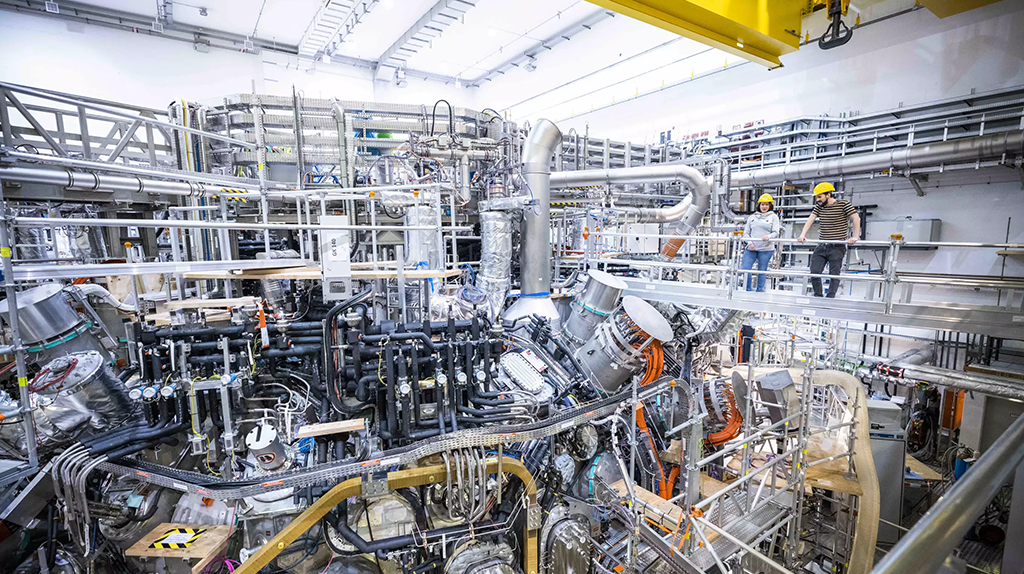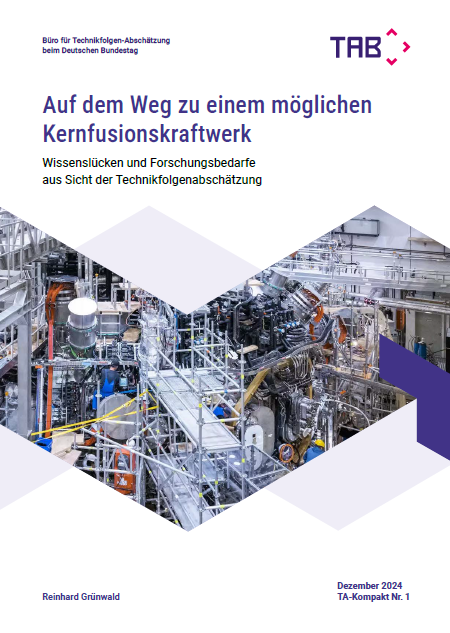
Towards a possible fusion power plant - knowledge gaps and research needs from the perspective of technology assessment
- Project team:
- Thematic area:
- Topic initiative:
Committee on Education, Research and Technology Assessment
- Analytical approach:
- Startdate:
2023
- Enddate:
2024
The study was approved by the Committee for Education, Research and Technology Assessment on 4 December 2024.
In a nutshell
- The controlled fusion of atomic nuclei releases large amounts of energy. Harnessing this energy has always been the goal of fusion research. Recent progress gives hope that the technical realisation of an energy-producing fusion plasma could be imminent.
- However, the road to power generation in possible commercial fusion power plants is still long and will require decades of effort in basic and applied research and engineering development.
- For commercial fusion power plants to be connected to the grid around the middle of the century, the scientific and technical feasibility of energy production from controlled nuclear fusion is a necessary but by no means sufficient condition.
- From the perspective of technology assessment, fundamental questions arise on which the success or failure of fusion technology crucially depends.
- These relate in particular to questions of economic efficiency, integration into an energy system characterised by renewable energies, environmental properties (e.g. contribution to climate protection, resource requirements and radioactive inventory, emissions and waste), but also questions of social sustainability, such as distribution and acceptance issues. There are also dual-use and proliferation issues.
Twelve questions - twelve answers
In the light of the renewed debate on possible commercial fusion power plants since 2023, this TA-Kompakt study discusses what challenges still need to be overcome for the construction and operation of such future power plants, and what characteristics fusion power plants are likely to have.
What materials are suitable for building fusion power stations?
- The components of a fusion power plant that are exposed to the plasma have to withstand extreme conditions, comparable to those on the surface of the sun.
- The intense bombardment of fusion neutrons can damage materials and make them radioactive.
- Taken together, the criteria to be met represent an enormous challenge for materials development.
- Irradiation tests are essential to develop and test resistant materials. The planned test facility (IFMIF-DONES) is urgently needed.
How are fusion power plants supplied with tritium fuel?
- Only a very limited amount of tritium is available worldwide for civil use. It is sufficient for the operation of ITER. But even for DEMO this is not certain from today's perspective.
- It is very likely that no tritium will be available for additional tritium-consuming facilities.
- Developing additional sources of tritium is difficult and requires a lead time of at least 10 years.
- During operation, fusion power plants need to produce more tritium than they consume through so-called breeding. The technologies required for this have hardly been developed and tested.
- The question of whether it is technically possible for power plants to be self-sufficient in tritium should be answered as a matter of priority.
- The currently planned test programme is not sufficient to test the tritium self-sufficiency of DEMO.
Will privately funded start-ups develop fusion power plants much faster than publicly funded projects?
How economical can electricity from nuclear fusion be?
- Specific predictions on the cost of fusion power generation can only be speculative at this stage.
- Fusion power plants will require large investments and a long capital lock-in period.
- The complexity of fusion power plants means that cost reductions due to learning effects are likely to be small.
- Investment in fusion power plants will be difficult to realise in liberalised energy markets if the associated business risk is not mitigated by the public sector.
- Grid operation and electricity market requirements are likely to be very high hurdles for the first fusion power plants.
What role could fusion power plants play in an electricity system characterised by renewable energies?
- To compensate for the intermittent nature of solar and wind power, we need power plants that can be controlled quickly and at low cost.
- Fusion power plants will not be able to fulfil this role in the foreseeable future.
- Applications such as seawater desalination, industrial process heat or hydrogen production may be better suited as pilot markets for fusion energy than the electricity sector.
Could fusion power plants help alleviate energy poverty in developing countries?
Are small reactors better than large ones?
- Small reactors promise advantages such as a significantly lower investment requirement and a possible cost reduction through series production.
- The prerequisite for realizing these advantages is the reliable sale of larger quantities.
- It is unclear whether small fusion power plants will be technically feasible.
How can fusion power plants contribute to climate protection?
Are the necessary raw materials available in sufficient quantities?
- Fusion power plants require highly specialised structural and functional materials. The examples of helium, beryllium and lithium illustrate several potential bottlenecks:
- Helium, a by-product of natural gas production, could become scarce as natural gas production declines.
- Beryllium is not available in sufficient quantities for a major fusion expansion programme.
- Lithium is available in sufficient quantities, but the lack of production capacity for the required isotope Li-6 could prove to be a significant obstacle.
Is radioactive waste produced?
- The aim is to ensure that no long-lived and highly radioactive waste is produced during the operation of fusion power plants.
- Whether this can be achieved will depend on progress in materials development over the next few years.
- Unlike nuclear fission, fusion technology does not produce long-lived, highly radioactive waste from spent fuel.
- A forward-looking and comprehensive strategy for the prevention and management of radioactive waste is needed.
What are the risks of proliferation of nuclear weapons materials and know-how?
- As an explosive booster, tritium is a component of advanced nuclear weapon designs.
- In order to reliably prevent militarily relevant quantities of tritium from being diverted from fusion power plants, an extremely high level of equipment and administrative effort is required.
- It is technically possible to breed weapons-grade plutonium in sufficient quantities for warheads in fusion power plants.
- The necessary conversions (such as the installation of uranium-containing breeding blankets) are easily detectable. The prerequisite is that verification measures are developed and implemented internationally.
- Experimental facilities for laser/inertial confinement fusion and the simulation methods developed for this purpose are suitable for generating know-how for the development of nuclear weapons.
- In this way, non-nuclear weapon states could attempt to circumvent the restriction on the development or further development of nuclear weapons imposed by the Comprehensive Test Ban Treaty.
What could an internationally binding regulation look like?
- As an explosive booster, tritium is a component of advanced nuclear weapon designs.
- Preventing the diversion of militarily relevant quantities of tritium from fusion power plants requires an extremely high level of technical and administrative effort.
- It is technically possible to grow enough weapons-grade plutonium for warheads in fusion power plants.
- The necessary conversions (such as the installation of uranium-containing breeding blankets) are easily detectable. This requires the development and implementation of international verification measures.
- Experimental facilities for laser/inertial confinement fusion and the simulation methods developed for this purpose are suitable for generating know-how for the development of nuclear weapons.
- In this way, non-nuclear-weapon states could attempt to circumvent the restrictions on the development or further development of nuclear weapons imposed by the Comprehensive Test Ban Treaty.
Methodical approach
In terms of methodology, the present study is based on the topic areas of TAB Working Report No. 75: Nuclear fusion of 2002, on an evaluation of the scientific literature and on interviews with ten experts in the period from November 2023 to February 2024. These were carried out on an exploratory basis in order to identify topics for further research and to validate the assessments made.
As the time available for this TA Compact study was limited to only 10 working weeks, not all topics could be analysed in depth. Instead, some topics were examined briefly and presented in outline.
In the media
-
ausgestrahlt.de (20.08.2025), Die Fusionsfalle.
-
theeuropean.de (11.06.2025), Münchner Start-up will die Sonne auf die Erde holen - und bekommt Rekord-Investitionen.
-
tagesschau.de (12.05.2025), Energiegewinnung: Der lange Weg zum Kernfusionsreaktor.
-
br.de (15.04.2025), Kernfusion - Wann kommen die ersten Reaktoren?
-
rbb-online.de | Kontraste (03.04.2025), "Mission Kernfusion". Gamechanger für die Energiewende oder Fehlinvestition? (mit Reinhard Grünwald)
-
nd-aktuell.de | (03.04.2025), Kernfusion: Nicht geeignet für die Energiewende.
-
zeit.de(+) (14.03.2025), Fusionskraftwerke: So viel Gratis-Energie!
-
tagesschau.de (10.02.2025), Klimafakten: Rückkehr zur Atomkraft – mehr Kosten als Nutzen.
-
swr.de (31.01.2025), Der deutsche Ausbruch aus der Atomenergie – War das wirklich eine gute Entscheidung? Ua mit TAB-Fusionsexperte Reinhard Grünwald zu den Zukunftsperspektiven der Kernenergie.
-
mdr.de (17.01.2025), Fusionskraftwerk: Warum die Kernfusion unser Energieproblem (noch) nicht löst.
-
faz.net (+) (12.01.2025), TAB-Studie zur Kernfusion: Wann kommen die ersten Fusionskraftwerke?
-
elperiodicodelaenergia.com (11.01.2025), Die Kernfusion kann die Schwankungen der erneuerbaren Energien nicht ausgleichen.
-
fr.de (11.01.2025), CDU-Flirt mit der Kernenergie: Merz-Vorschläge für die gepriesene Kernfusion von Experten zerlegt.
-
taz.de (10.01.2025), Energieerzeugung: Noch viele Hürden für Fusionskraftwerke.
-
edison.media (10.01.2025), Energieerzeugung: Noch viele Hürden für Fusionskraftwerke.
-
deutschlandfunk.de (09.01.2025), Der lange Weg zum Kraftwerk: Neuer Bericht bremst Erwartungen an die Kernfusion.
-
nzz.ch (+) (09.01.2025), Studie aus Deutschland: Strom aus Fusionskraftwerken verträgt sich schlecht mit Erneuerbaren.
-
energate-messenger.ch (+) (09.01.2025), Studie: Noch viele Hürden für Fusionskraftwerke.
-
zeit.de (+) (09.01.2025), Energieversorgung: Kernfusion in Deutschland? Zu teuer, zu kompliziert, zu spät. Die Kernfusion löst bald unser Energieproblem, klimaneutral und günstig: Damit werben FDP und Union im Wahlkampf. Ein Expertenbericht ordnet die Technik realistisch ein.
- stern.de (+) (09.01.2025), Fusionsenergie: Sonnenfeuer soll Deutschlands Energieprobleme lösen. Kann das klappen? Werden Kernfusionskraftwerke uns bald gigantische Mengen Energie liefern oder ist die Technik zu teuer und kommt zu spät? Ein neuer Bericht gibt. Antworten
- focus.de (09.01.2025), „Eher ein Lückenfüller“. Warum selbst die Kernfusion keine Chance gegen Solar und Wind hat.
- sciencemediacenter.de (09.01.2025), Kernfusionskraftwerke: Herausforderungen und Einsatzmöglichkeiten. Expert/innen-Statements zur Einordnung der Kompakt-Studie des TAB.
Previous publications on the topic
Grunwald, A.; Grünwald, R.; Oertel, D.; Paschen, H.
2002. Büro für Technikfolgen-Abschätzung beim Deutschen Bundestag (TAB). doi:10.5445/IR/1000137651
Grunwald, A.; Grünwald, R.; Oertel, D.; Paschen, H.
2002. Büro für Technikfolgen-Abschätzung beim Deutschen Bundestag (TAB). doi:10.5445/IR/1000102229
Grünwald, R.; Oertel, D.
2002. Technikfolgenabschätzung, Theorie und Praxis, 11 (3-4), 126–130. doi:10.14512/tatup.11.3-4.126

